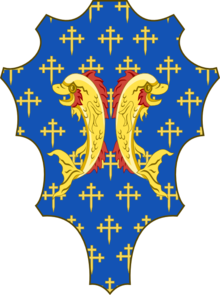
Lorenzo di Piero de' Medici, known as Lorenzo the Magnificent, was an Italian statesman, the de facto ruler of the Florentine Republic, and the most powerful patron of Renaissance culture in Italy. Lorenzo held the balance of power within the Italic League, an alliance of states that stabilized political conditions on the Italian Peninsula for decades, and his life coincided with the mature phase of the Italian Renaissance and the golden age of Florence. As a patron, he is best known for his sponsorship of artists such as Botticelli and Michelangelo. On the foreign policy front, Lorenzo manifested a clear plan to stem the territorial ambitions of Pope Sixtus IV, in the name of the balance of the Italian League of 1454. For these reasons, Lorenzo was the subject of the Pazzi conspiracy (1478), in which his brother Giuliano was assassinated. The Peace of Lodi of 1454 that he supported among the various Italian states collapsed with his death. He is buried in the Medici Chapel in Florence.

The Pazzi were a powerful family in the Republic of Florence. Their main trade during the fifteenth century was banking. In the aftermath of the Pazzi conspiracy in 1478, members of the family were banished from Florence and their property was confiscated; the family name and coat-of-arms were permanently suppressed by order of the Signoria.

The Republic of Florence, known officially as the Florentine Republic, was a medieval and early modern state that was centered on the Italian city of Florence in Tuscany, Italy. The republic originated in 1115, when the Florentine people rebelled against the Margraviate of Tuscany upon the death of Matilda of Tuscany, who controlled vast territories that included Florence. The Florentines formed a commune in her successors' place. The republic was ruled by a council known as the Signoria of Florence. The signoria was chosen by the gonfaloniere, who was elected every two months by Florentine guild members.

Lorenzo di Piero de' Medici was the ruler of Florence from 1516 until his death in 1519. He was also Duke of Urbino during the same period. His daughter Catherine de' Medici became Queen Consort of France, while his illegitimate son, Alessandro de' Medici, became the first Duke of Florence.
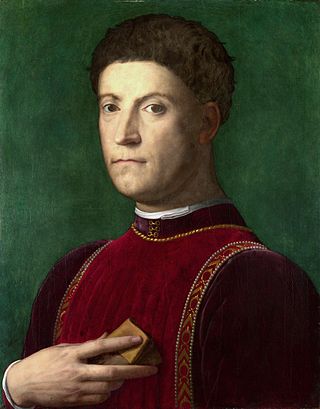
Piero di Cosimo de' Medici, known as Piero the Gouty, was the de facto ruler of Florence from 1464 to 1469, during the Italian Renaissance.

Giuliano di Lorenzo de' Medici KG was an Italian nobleman, the third son of Lorenzo the Magnificent, and a ruler of Florence.
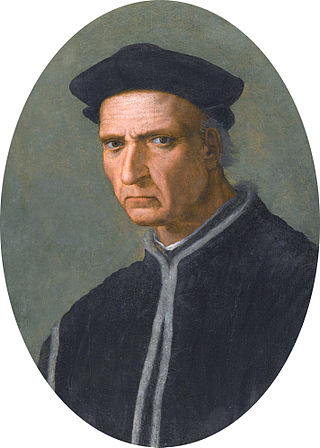
Piero di Tommaso Soderini, also known as Pier Soderini, was an Italian statesman of the Republic of Florence.
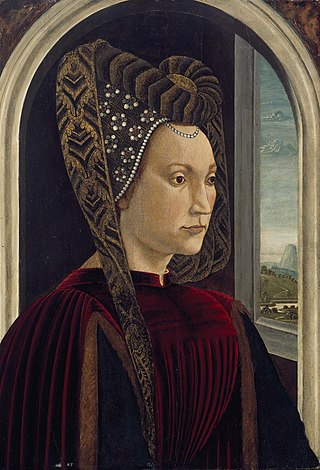
Clarice Orsini (1453–1488) was the daughter of Jacopo Orsini, and his wife and cousin Maddalena Orsini both from the Orsini family, a great Roman noble house and was the wife of Lorenzo de' Medici.

The palleschi, also known as bigi, were partisans of the Medici family in Florence. The name derived by the Medici coat-of-arms, bearing six 'balls' (palle).
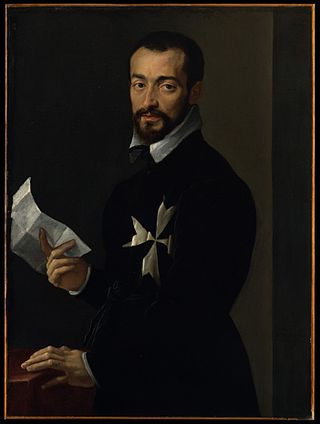
Jacopo Salviati was a Florentine politician and son-in-law of Lorenzo de' Medici. On 10 September 1486 he married Lorenzo's daughter Lucrezia de' Medici, with whom he had ten children. The son of Giovanni Salviati and Maddalena Gondi, he devoted himself to the economic affairs of the family, becoming very wealthy. He then engaged in political life. He was Prior of the Guilds of Florence in 1499 and 1518, then gonfaloniere of Justice in 1514. In 1513, he was appointed ambassador to Rome.

Lucrezia Tornabuoni was an Italian noblewoman, wife of Piero di Cosimo de' Medici, de facto Lord of Florence and his political adviser. Lucrezia had significant political influence during the rule of her husband and then of her son Lorenzo the Magnificent, investing in several institutions and improving relationships to support the needs of the poor. She was also a patroness of the arts who wrote several poems and plays.
Paolo Antonio Soderini was a noble Florentine jurist active in the anti-Medicean Florentine republic, who spent some years resident at Rome.

Bernardo Rucellai, also known as Bernardo di Giovanni Rucellai or Latinised as Bernardus Oricellarius, was a member of the Florentine political and social elite. He was the son of Giovanni di Paolo Rucellai (1403–1481) and father of Giovanni di Bernardo Rucellai (1475–1525). He was married to Nannina de' Medici, the elder sister of Lorenzo de' Medici, and was thus uncle to Popes Leo X and Clement VII, who were cousins. Oligarch, banker, ambassador and man of letters, he is today remembered principally for the meetings of the members of the Accademia Platonica in the Orti Oricellari, the gardens of his house in Florence, the Palazzo Rucellai, where Niccolò Machiavelli gave readings of his Discorsi.

Gentile de' Becchi was an Italian bishop, diplomat, orator and writer. He was a member of the Platonic Academy of the Medici of Florence and tutor of Lorenzo the Magnificent and his son Giovanni de' Medici, later Pope Leo X. Of his writings there exist many letters, poems in Latin, and prayers which are praised by historian Cecil Grayson as his finest works.
Bianca Maria di Piero de' Medici was a member of the de' Medici family, de facto rulers of Florence in the late 15th century. She was the daughter of Piero di Cosimo de' Medici, de facto ruler of the Florentine Republic, and sister of Lorenzo de' Medici, who succeeded his father in that position. She married Guglielmo de' Pazzi, a member of the Pazzi family. She was a musician, and played the organ for Pope Pius II and the future Pope Alexander VI in 1460; she was a landowner.

Medici is a historical drama television series created by Frank Spotnitz and Nicholas Meyer. The series was produced by Italian companies Lux Vide and Rai Fiction, in collaboration with Spotnitz's Big Light Productions. The series follows the House of Medici, bankers of the Pope, in 15th-century Florence. Each season follows the events of a particular moment of the family's history exploring the political and artistic landscape of Renaissance Italy.
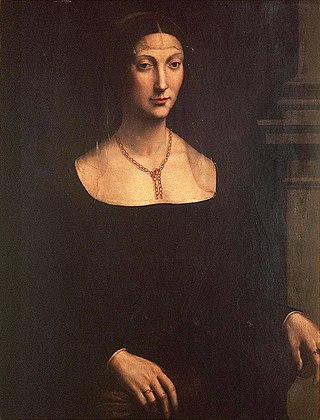
Contessina Antonia Romola di Lorenzo de' Medici was an Italian noblewoman, ninth child and fifth and last daughter of Lorenzo the Magnificent, Lord of Florence, and his wife Clarice Orsini. She was the wife of the Florentine Piero Ridolfi, later made Count Palatine by her elder brother Pope Leo X. She was the cousin and foster sister of Pope Clement VII.

Andrea di Guglielmo de' Pazzi was an Italian politician of Republic of Florence, known for having commissioned the Pazzi Chapel from Filippo Brunelleschi and for being the father of Jacopo de' Pazzi and the grandfather of Francesco and Guglielmo de' Pazzi.

Renato di Piero de' Pazzi was an Italian politician and banker by Republic of Florence, who died in the riots that followed the failure of the Pazzi conspiracy against the Medici family.

Semiramide Appiano was an Italian noblewoman, daughter of the Lord of Piombino Jacopo III Appiano and wife of Lorenzo di Pierfrancesco de' Medici. She was the niece of the famous Simonetta Vespucci, Botticelli's muse.
